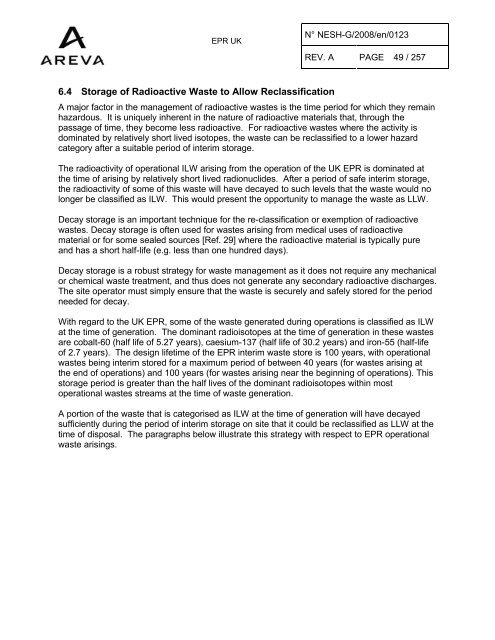Solid Radioactive Waste Strategy Report.pdf - UK EPR
Solid Radioactive Waste Strategy Report.pdf - UK EPR
Solid Radioactive Waste Strategy Report.pdf - UK EPR
Create successful ePaper yourself
Turn your PDF publications into a flip-book with our unique Google optimized e-Paper software.
<strong>EPR</strong> <strong>UK</strong><br />
N° NESH-G/2008/en/0123<br />
REV. A PAGE 49 / 257<br />
6.4 Storage of <strong>Radioactive</strong> <strong>Waste</strong> to Allow Reclassification<br />
A major factor in the management of radioactive wastes is the time period for which they remain<br />
hazardous. It is uniquely inherent in the nature of radioactive materials that, through the<br />
passage of time, they become less radioactive. For radioactive wastes where the activity is<br />
dominated by relatively short lived isotopes, the waste can be reclassified to a lower hazard<br />
category after a suitable period of interim storage.<br />
The radioactivity of operational ILW arising from the operation of the <strong>UK</strong> <strong>EPR</strong> is dominated at<br />
the time of arising by relatively short lived radionuclides. After a period of safe interim storage,<br />
the radioactivity of some of this waste will have decayed to such levels that the waste would no<br />
longer be classified as ILW. This would present the opportunity to manage the waste as LLW.<br />
Decay storage is an important technique for the re-classification or exemption of radioactive<br />
wastes. Decay storage is often used for wastes arising from medical uses of radioactive<br />
material or for some sealed sources [Ref. 29] where the radioactive material is typically pure<br />
and has a short half-life (e.g. less than one hundred days).<br />
Decay storage is a robust strategy for waste management as it does not require any mechanical<br />
or chemical waste treatment, and thus does not generate any secondary radioactive discharges.<br />
The site operator must simply ensure that the waste is securely and safely stored for the period<br />
needed for decay.<br />
With regard to the <strong>UK</strong> <strong>EPR</strong>, some of the waste generated during operations is classified as ILW<br />
at the time of generation. The dominant radioisotopes at the time of generation in these wastes<br />
are cobalt-60 (half life of 5.27 years), caesium-137 (half life of 30.2 years) and iron-55 (half-life<br />
of 2.7 years). The design lifetime of the <strong>EPR</strong> interim waste store is 100 years, with operational<br />
wastes being interim stored for a maximum period of between 40 years (for wastes arising at<br />
the end of operations) and 100 years (for wastes arising near the beginning of operations). This<br />
storage period is greater than the half lives of the dominant radioisotopes within most<br />
operational wastes streams at the time of waste generation.<br />
A portion of the waste that is categorised as ILW at the time of generation will have decayed<br />
sufficiently during the period of interim storage on site that it could be reclassified as LLW at the<br />
time of disposal. The paragraphs below illustrate this strategy with respect to <strong>EPR</strong> operational<br />
waste arisings.

















